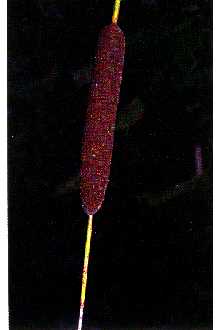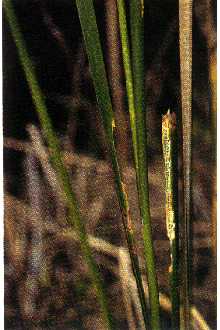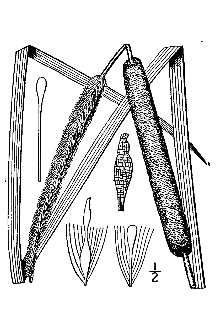Typha angustifolia L. var. calumetensis Peattie
Scientific Name: Typha angustifolia L. var. calumetensis Peattie

| General Information | |
|---|---|
| Usda Symbol | TYANC |
| Group | Monocot |
| Life Cycle | Perennial |
| Growth Habits | Forb/herb |
| Native Locations | TYANC |
Plant Guide
Alternate Names
flags, rushes, bulrushes, cat o’nine tails, Cossack asparagus, reed mace, baco
Uses
Caution: This species can be very invasive in disturbed wetlands. Please read about the environmental concerns under Management. Ethnobotanic: All parts of the cattail are edible when gathered at the appropriate stage of growth. The young shoots are cut from the rhizomes (underground stems) in the spring when they are about 4 to 16 inches long. The base of the stem where it attaches to the rhizome can be boiled or roasted like potatoes. The young flower stalks can be taken out of their sheaths and can be boiled or steamed just like corn. Cattail pollen is a fine substitute for flours. It is a bright yellow or green color, and turns pancakes, cookies or biscuits a pretty yellow color (which children love). The rhizomes and lower stems have a sweet flavor and can be eaten raw, baked, roasted, or broiled. Cattail rhizomes are fairly high in starch content; this is usually listed at about 30% to 46%. The core can be ground into flour. One acre of cattails would yield about 6,475 pounds of flour (Harrington 1972). This flour would probably contain about 80 % carbohydrates and around 6% to 8% protein. Since cattails occur around the world, it is a potential source of food for the worlds' population. The Klamath and Modoc peoples of northern California and southern Oregon made flexible baskets of twined cattail. Cattails were also twined to form mats of varying sizes for sleeping, sitting, working, entertaining, covering doorways, providing shade, and a myriad of other uses. Lengths of cattail were plied into rope or other size cordage, and cattail rope was used in some areas to bind bundles of tule into tule boats. Air pockets or aerenchyma in the stems provided the buoyancy for good boat-building material. Brother Alfred Brousseau © St. Mary’s College @ CalPhotos The Cahuilla Indians used the stalks for matting, bedding material, and ceremonial bundles (Barrows 1967). Some tribes used the leaves and sheath bases as caulking materials. Apaches used the pollen in female puberty ceremonies. After dipping the spike in coal oil, the stalk makes a fine torch. The fluff can also be used as tinder, insulation, or for lining baby cradleboards. The down is used for baby beds (Murphey 1959). Wildlife: The multitudes of tiny, wind-carried seeds are too small and too hairy to be attractive to birds (Hotchkiss and Dozier 1949). In a few exceptions, the seeds are eaten by several duck species. Cattail rootstocks are much more valuable as food for wildlife than are the seeds. Geese and muskrats prefer the stems and roots. Moose and elk eat fresh spring shoots. Shelter and nesting cover are provided for long-billed marsh wrens, redwing blackbirds, and yellow-headed blackbirds. Conservation: This plant is used widely for wetland restoration and constructed wetlands for tertiary water treatment. Typha species can become invasive in disturbed habitats.
Status
Please consult the PLANTS Web site and your State Department of Natural Resources for this plant’s current status, such as, state noxious status, and wetland indicator values.
Description
Cattails are herbaceous, colonial, rhizomatous, perennial plants with long, slender, green stalks topped with brown, fluffy, sausage-shaped flowering heads. Typha angustifolia plants are 15-30 dm tall. The spike-like, terminal, cylindric inflorescence has staminate flowers above and pistillate flowers below. The naked axis between the staminate and pistillate flowers is generally 1-8 cm. The spike is medium to dark brown. The basal leaves are thin with parallel veins running their long, narrow length. The leaves are 4-12 mm wide when fresh, 3-8 mm wide when dry. Typha angustifolia generally occurs in deeper water than Typha latifolia. Typha angustifolia has fewer and larger rhizomes, resulting in a low rate of cloning but enabling it to grow in deeper water than Typha latifolia. Typha angustifolia has a higher allocation to sexual reproduction. Cattails spread both vegetatively and by seed, particularly under drawdown conditions.
Distribution
Cattails are always found in or near water, in marshes, ponds, lakes, and depressional areas, They are obligate wetland indicator plant species, Cattails tolerate perennial flooding, reduced soil conditions, and moderate salinity, With influxes of nutrients or freshwater, cattails are aggressive invaders in both brackish salt marshes and freshwater wetlands, Narrow-leaved cattails are found in marshes at elevations <2000 m, Use soil moisture sensors to measure the soil moisture of Typha angustifolia L. var. calumetensis Peattie., They grow throughout North America and Eurasia (Hickman 1993), For current distribution, please consult the Plant Profile page for this species on the PLANTS Web site,
Establishment
Typha species may be planted from bare rootstock or seedlings from container stalk or directly seeded into the soil. Bare rootstock or seedlings are preferred revegetation methods where there is moving water. Typha seeds germinate readily and are a cost-effective means to propagate cattail on moist soils. Typha species can be invasive in disturbed wetland situations and become a monoculture.
Seed Collections
• Select seed collection sites where continuous stands with few intermixed species can easily be found and obtain permission for seed collection. • Seeds can be harvested when they are slightly immature. It is important to harvest the staminate stalks before they dry and blow away. • Harvest by using either hand clippers, cutting the stem off below the seed heads, or by stripping the seed heads off of the stalk. Use a seed cleaner to process the seeds. Dry and store the seeds in brown paper or burlap bags. • Plant cleaned seed in fall. Plant in clean, weed-free, moist seedbed. Flooded or ponded soils will significantly increase seedling mortality. • Broadcast seed and roll in or rake 1/4" to 1/2" from the soil surface. Some seed may be lost due to scour or flooding. Recommended seed density is unknown at this time. Seed Germination in Greenhouse • Plant in the greenhouse in 1" x 1" x 2" pots, 1/4" under the soil surface. Keep soil surface moist. Greenhouse temperature should be 100° F (plus or minus 5° F). Seeds will begin to germinate after a couple weeks in warm temperatures. • Plants will be ready in 100-120 days to come out as plugs. By planting seeds in August, plugs are ready to plant in the soil by November. These plants are very small. Growing plants to a larger size will result in increased revegetation success.
Live Plant Collections
• No more than 1/4 of the plants in an area should be collected. If no more than 0.09 m² (1 ft²) is removed from a 0.4 m² (4 ft²) area, the plants will grow back into the hole in one good growing season. A depth of 15 cm (6 in) is sufficient for digging plugs. This will leave enough plants and rhizomes to grow back during the growing season. • Donor plants that are drought-stressed tend to have higher revegetation success. • Live transplants should be planted in moist (not flooded or anoxic) soils as soon as possible. Plants should be transported and stored in a cool location prior to planting. Plugs may be split into smaller units, generally no smaller than 6 x 6 cm (2.4 x 2.4 in), with healthy rhizomes and tops. The important factor in live plant collections is to be sure to include a growing bud in either plugs or rhizomes. Weeds in the plugs should be removed by hand. For ease in transport, soil may be washed gently from roots. The roots should always remain moist or in water until planted. • Clip leaves and stem from 15 to 25 cm (6 to 10 inches); this allows the plant to allocate more energy into root production. Plant approximately 1 meter apart. Plants should be planted closer together if the site has fine soils such as clay or silt, steep slopes, or prolonged inundation. • Ideally, plants should be planted in moist soils in late fall just after the first rains (usually late October to November). This enables plant root systems to become established before heavy flooding and winter dormancy occurs. Survival is highest when plants are dormant and soils are moist. • Fertilization is very helpful for plant growth and reproduction. Many more seeds are produced with moderate fertilization.
Management
Heavy grazing will eliminate Typha species, as well as other native species, from riparian corridors. However, cattails are fairly resistant to moderate grazing, providing wet soils are not compacted. Because cattails have relatively little value for ducks, they are often regarded as undesirable weeds in places intended primarily for ducks. It has been found that mowing cattails after the heads are well–formed, but not mature, then following up with another mowing about a month later (when new growth is two or three feet high) will kill at least 75% of the plants. This will enable other emergent vegetation with more palatable and nutritious seeds to become established. Environmental Concerns: Ecologically, cattails tend to invade native plant communities when hydrology, salinity, or fertility change. In this case, they out-compete native species, often becoming monotypic stands of dense cattails. Maintaining water flows into the wetland, reducing nutrient input, and maintaining salinity in tidal marshes will help maintain desirable species composition. If cattails begin to invade, physical removal may be necessary. Over the past century, we have dramatically increased the range of this species and have brought T. angustifolia and T. latifolia together with the production of the hybrid T. glauca. This taxon is extremely aggressive and will out-compete either parent. The methods of control include clipping and floocing >12 inches, herbicides, and hydrology management (Melvin 2000). Please contact your local agricultural extension specialist or county weed specialist to learn what works best in your area and how to use it safely. Always read label and safety instructions for each control method. Trade names and control measures appear in this document only to provide specific information. USDA, NRCS does not guarantee or warranty the products and control methods named, and other products may be equally effective. Cultivars, Improved and Selected Materials (and area of origin) Please check the Vendor Database, expected to be on-line through the PLANTS Web site in 2001 by clicking on Plant Materials. This species is readily available for native plant nurseries specializing in wetland plants.
References
CalPhotos 2000. Typha angustifolia. <http://elib.cs.berkeley.edu/cgi/img_query?seq_num=11010&one=T>. Version: 000321. CalFlora, Inc., Berkeley, California. Clarke, C.B. 1977. Edible and useful plants of California. University of California Press. 280 pp. Grace, J.B. 1985. Juvenile vs. adult competitive abilities in plants: size-dependence in cattails (Typha). Ecology 66(5):1630-1638. Grace, J.B. & R.G. Wetzel 1982. Variations in growth and reproduction within populations of two rhizomatous plant species: Typha latifolia and Typha angustifolia. Oecologia 53:258-263. Grace, J.B. & R.G. Wetzel 1981. Phenotypic and genotypic components of growth and reproduction in Typha latifolia: Experimental studies in marshes of differing successional maturity. Ecology 62(3):699-801. Harrington, H.D. 1972. Western edible wild plants. The University of New Mexico Press. 156 pp. Hoag, J. C. & M.E. Sellers (April) 1995. Use of greenhouse propagated wetland plants versus live transplants to vegetate constructed or created wetlands. Riparian/Wetland Project Information Series No. 7. USDA, NRCS, Plant Materials Center, Aberdeen, Idaho. 6 pp. Hickman, J.C. 1993. The Jepson manual. Higher plants of California. University of California Press. 1399 pp. Hotchkiss, N. & H.L. Dozier. Taxonomy and distribution of North American cat-tails. Am. Midl. Nat. 41:237-253. Keator, G., L. Yamane, & A. Lewis 1995. In full view. Three ways of seeing California plants. Heyday Books, Berkeley, California. Melvin, N. 2000. Personal communication. USDA, NRCS, National Wetland Science Institute, Laurel, Maryland. Roos-Collins, M. 1990. The flavors of home. A guide to wild edible plants of the San Francisco bay area. Heyday Books, Berkeley, California. 224 pp. Shay, J.M. & C.T. Shay 19??. Prairie marshes in western Canada, with specific reference to the ecology of five emergent macrophytes. Can. J. Bot. 64:443-454. USDA, NRCS 2000. The PLANTS database. Version: 000321. <http://plants.usda.gov>. National Plant Data Center, Baton Rouge, Louisiana.
Plant Traits
Growth Requirements
| Temperature, Minimum (°F) | -33 |
|---|---|
| Adapted to Coarse Textured Soils | Yes |
| Adapted to Fine Textured Soils | Yes |
| Adapted to Medium Textured Soils | Yes |
| Anaerobic Tolerance | High |
| CaCO3 Tolerance | Low |
| Cold Stratification Required | No |
| Drought Tolerance | Low |
| Fertility Requirement | Medium |
| Fire Tolerance | High |
| Frost Free Days, Minimum | 130 |
| Hedge Tolerance | None |
| Moisture Use | High |
| pH, Maximum | 8.5 |
| pH, Minimum | 3.7 |
| Planting Density per Acre, Maxim | 3700 |
| Planting Density per Acre, Minim | 2728 |
| Precipitation, Maximum | 60 |
| Precipitation, Minimum | 30 |
| Root Depth, Minimum (inches) | 10 |
| Salinity Tolerance | Medium |
| Shade Tolerance | Intolerant |
Morphology/Physiology
| After Harvest Regrowth Rate | Slow |
|---|---|
| Toxicity | None |
| Resprout Ability | No |
| Shape and Orientation | Erect |
| Active Growth Period | Spring |
| Bloat | None |
| C:N Ratio | Medium |
| Coppice Potential | No |
| Fall Conspicuous | No |
| Fire Resistant | No |
| Flower Color | Green |
| Flower Conspicuous | Yes |
| Foliage Color | Green |
| Foliage Porosity Summer | Moderate |
| Foliage Porosity Winter | Porous |
| Fruit/Seed Color | White |
| Nitrogen Fixation | None |
| Low Growing Grass | No |
| Lifespan | Long |
| Leaf Retention | No |
| Known Allelopath | No |
| Height, Mature (feet) | 4.9 |
| Growth Rate | Rapid |
| Growth Form | Rhizomatous |
| Fruit/Seed Conspicuous | Yes |
| Foliage Texture | Coarse |
Reproduction
| Vegetative Spread Rate | Rapid |
|---|---|
| Small Grain | No |
| Seedling Vigor | Medium |
| Seed Spread Rate | Rapid |
| Fruit/Seed Period End | Summer |
| Propagated by Tubers | No |
| Propagated by Sprigs | Yes |
| Propagated by Sod | No |
| Propagated by Seed | Yes |
| Propagated by Cuttings | No |
| Propagated by Container | No |
| Propagated by Bulb | No |
| Propagated by Bare Root | No |
| Fruit/Seed Persistence | Yes |
| Fruit/Seed Period Begin | Spring |
| Fruit/Seed Abundance | Medium |
| Commercial Availability | Routinely Available |
| Bloom Period | Late Spring |
| Propagated by Corm | No |
Suitability/Use
| Veneer Product | No |
|---|---|
| Pulpwood Product | No |
| Protein Potential | Low |
| Post Product | No |
| Palatable Human | Yes |
| Palatable Graze Animal | Low |
| Palatable Browse Animal | Low |
| Nursery Stock Product | No |
| Naval Store Product | No |
| Lumber Product | No |
| Fodder Product | No |
| Christmas Tree Product | No |
| Berry/Nut/Seed Product | No |


